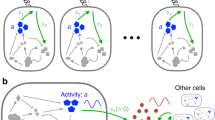Abstract
Quorum sensing is a phenomenon wherein the size of an ensemble (population density) decides its dynamical state. This happens when its constituting elements alter their dynamics coherently with the change in their population. In case of chaotic ensemble, as a precursor to the emergence of global chaotic synchronization, the chaotic elements undergo various dynamical transitions (chaotic state \(\rightarrow \) silent/periodic state \(\rightarrow \) periodic state/ intermittent chaos \(\rightarrow \) chaotic state) sequentially with the increase in their population. Among these sequence of quorum transitions, we mark the transition periodic state/intermittent chaos \(\rightarrow \) chaotic state (i.e the final quorum transition between the unsynchronized and synchronized chaotic states) as a ‘crowd synchrony’ transition for convenience. In contrast to the conventional quorum sensing mechanism, we study this population-based phenomenon by exploring the scenario wherein the chaotic elements interact via an element (of same kind) resting in a steady state, i.e the surrounding of the elements is not only dynamic but also incorporates the underlying features of the elements. Apart from the other advantages (discussed in the text), considering the surrounding of the elements as an element, resolves the issue regarding the dimensionality of the surround (which has not been addressed before) when more than one interacting species are involved. The proposed mechanism has been tested on two different class of chaotic oscillators: spiking neuron (i.e a relaxed biological oscillator) and Chua’s circuit, i.e a sinusoidal-type electrical oscillator (for the experimental verification).






Similar content being viewed by others
References
Konigsberg, I.R.: Diffusion-mediated control of myoblast fusion. Dev. Biol. 26, 133–152 (1971)
Martz, E., Steinberg, M.S.: The role of cell–cell contact in contact inhibition of cell division: a review and new evidence. J. Cell. Physiol. 79, 189–210 (1972)
DeHaan, R.L., Sachs, H.G.: Cell coupling in developing systems: the heart cell paradigm. Curr. Top. Dev. Biol. 7, 193–228 (1972)
Aldridge, J., Pye, E.K.: Cell density dependence of oscillatory metabolism. Nature 259, 670–671 (1976)
Dano, S., Sorensen, P.G., Hynne, F.: Sustained oscillations in living cells. Nature 402, 320–322 (1999)
Miller, M.B., Bassler, B.L.: Quorum sensing in bacteria. Ann. Rev. Microbiol. 55, 165–199 (2001)
Garcia-Ojalvo, J., Elowitz, M.B., Strogatz, S.H.: Modeling a synthetic multicellular clock: repressilators coupled by quorum sensing. Proc. Natl. Acad. Sci. USA 101(30), 10,955–10,960 (2004)
Waters, C.M., Bassler, B.L.: Quorum sensing: cell-to-cell communication in bacteria. Ann. Rev. Cell Dev. Biol. 21(1), 319–346 (2005)
Strogatz, S.H., Abrams, D.M., McRobie, A., Eckhardt, B., Ott, E.: Theoretical mechanics: crowd synchrony on the millennium bridge. Nature 438, 43–44 (2005)
Camilli, A., Bassler, B.L.: Bacterial small-molecule signaling pathways. Science 311(5764), 1113–1116 (2006)
De Monte, S., d’Ovidio, F., Dano, S., Sorensen, P.G.: Dynamical quorum sensing: population density encoded in cellular dynamics. Proc. Natl. Acad. Sci. 104(47), 18,377–18,381 (2007)
Danino, T., Mondragon-Palomino, O., Tsimring, L., Hasty, J.: A synchronized quorum of genetic clocks. Nature 463, 326–330 (2010)
Gregor, T., Fujimoto, K., Masaki, N., Sawai, S.: The onset of collective behavior in social amoebae. Science 328(5981), 1021–1025 (2010)
Chen, A.: Modelling a synthetic biological chaotic system: relaxation oscillators coupled by quorum sensing. Nonlinear Dyn. 63, 711–718 (2011)
Rubin, J.J., Rubin, J.E., Ermentrout, G.B.: Analysis of synchronization in a slowly changing environment: how slow coupling becomes fast weak coupling. Phys. Rev. Lett. 110, 204,101 (2013)
Singh, H., Parmananda, P.: Alternate coupling mechanism for dynamical quorum sensing. J. Phys. Chem. A 116(42), 10,269–10,275 (2012)
Toth, R., Taylor, A.F., Tinsley, M.R.: Collective behavior of a population of chemically coupled oscillators. J. Phys. Chem. B 110(20), 10,170–10,176 (2006)
Taylor, A.F., Tinsley, M.R., Wang, F., Huang, Z., Showalter, K.: Dynamical quorum sensing and synchronization in large populations of chemical oscillators. Science 323(5914), 614–617 (2009)
Tinsley, M.R., Taylor, A.F., Huang, Z., Showalter, K.: Emergence of collective behavior in groups of excitable catalyst-loaded particles: spatiotemporal dynamical quorum sensing. Phys. Rev. Lett. 102, 158,301 (2009)
Tinsley, M., Taylor, A., Huang, Z., Wang, F., Showalter, K.: Dynamical quorum sensing and synchronization in collections of excitable and oscillatory catalytic particles. Phys. D Nonlinear Phenom. 239(11), 785–790 (2010)
Li, B.W., Fu, C., Zhang, H., Wang, X.: Synchronization and quorum sensing in an ensemble of indirectly coupled chaotic oscillators. Phys. Rev. E 86, 046,207 (2012)
Zamora-Munt, J., Masoller, C., Garcia-Ojalvo, J., Roy, R.: Crowd synchrony and quorum sensing in delay-coupled lasers. Phys. Rev. Lett. 105, 264,101 (2010)
Cohen, E., Rosenbluh, M., Kanter, I.: Phase transition in crowd synchrony of delay-coupled multilayer laser networks. Opt. Express 20, 19,683–19,689 (2012)
Hellen, E.H., Dana, S.K., Zhurov, B., Volkov, E.: Electronic implementation of a repressilator with quorum sensing feedback. PLoS One 8, e62,997 (2013)
Singh, H., Parmananda, P.: Quorum sensing via static coupling demonstrated by Chua’s circuits. Phys. Rev. E 88, 040,903 (2013)
Schwab, D.J., Baetica, A., Mehta, P.: Dynamical quorum-sensing in oscillators coupled through an external medium. Phys. D Nonlinear Phenom. 241(21), 1782–1788 (2012)
Hindmarsh, J.L., Rose, R.M.: A model of neuronal bursting using three coupled first order differential equations. Proc. R. Soc. Lond. B Biol. Sci. 221(1222), 87–102 (1984)
Benettin, G., Galgani, L., Giorgilli, A., Strelcyn, J.M.: Lyapunov characteristic exponents for smooth dynamical systems and for hamiltonian systems; a method for computing all of them. part 1: Theory. Meccanica 15(1), 9–20 (1980)
Wolf, A., Swift, J.B., Swinney, H.L., Vastano, J.A.: Determining lyapunov exponents from a time series. Phys. D 16, 285–317 (1985)
Shinomoto, S., Kuramoto, Y.: Phase transitions in active rotator systems. Prog. Theor. Phys. 75(5), 1105–1110 (1986)
Pikovsky, A.S., Rosenblum, M., Kurths, J.: Synchronization: A Universal Concept in Nonlinear Sciences. Cambridge University Press, Cambridge (2001)
Kuramoto, Y.: Chemical Oscillations, Waves and Turbulence. Springer, Berlin (1984)
Acknowledgments
Financial support from IIT Bombay and DST, India is acknowledged.
Author information
Authors and Affiliations
Corresponding author
Rights and permissions
About this article
Cite this article
Singh, H., Parmananda, P. Crowd synchrony in chaotic oscillators. Nonlinear Dyn 80, 767–776 (2015). https://doi.org/10.1007/s11071-015-1904-9
Received:
Accepted:
Published:
Issue Date:
DOI: https://doi.org/10.1007/s11071-015-1904-9




